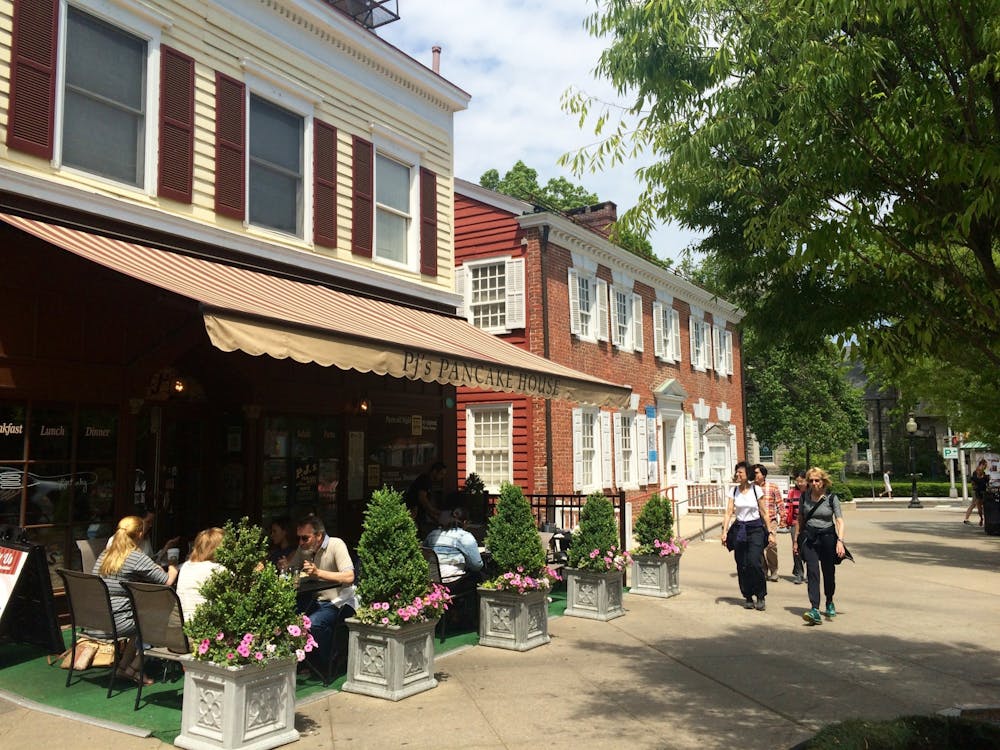By Antonia Devine princetonian 'street' writier
Upon walking into the Lucas Gallery, where the walls are normally crowded with attempts at profound and unique art, I was surprised to find the room nearly bare and the light a deep, almost murky blue. Though initially skeptical as to the value of the installation art I was approaching, I was pleasantly surprised by the sound of waves crashing against the rocks. Indeed, "Waterway," the senior thesis of Jessica Inocencio '05, was a charming homage to the "overwhelming presence" and "mystery, breadth and beauty" of the ocean.
The exhibition gets its name from the dominant object, if it can be called that, in the room: she has set up a roughly 33 foot-long dock on the floor, painted a patchy, scuffed white. Placed into cutout sections of the wood planks are four televisions that loop images of the ocean; she captured both pleasant days at the beach with sunbathers and a tumultuous sea tossed by rapacious winds. Overhead, a recording played sounds of everything from the quietest drip and the gentlest wave to the most booming crash and irritating seagulls' screech. Inocencio compiled these images and sounds from various Costa Rican beaches over the summer.
Though installation art has the tendency to favor the random and eccentric over the interesting and beautiful, it was impressive how Inocencio manipulated these disconnected, almost arbitrary images of the beach into a seamless and extraordinary representation of how dramatically the sea can change. It was clear from the audio recordings and video clips, which were timed to reach crescendos of noise and power simultaneously, that the viewer was meant to simultaneously love and fear the power and beauty of water.
An equally interesting and "nature-based" thesis was that of senior Clare Huang. Her show was a compilation of 59 photographs that she took during two visits to her native Taiwan. During this time, she traveled down the Eastern coast, documenting the "rural poverty and degradation [she] encountered." The subjects of the pictures were water and landscapes, taken during both the winter and summer. Huang started out as a painter, a fact which is immediately obvious in her presentation and "palette" — as she described it — of each photograph. The colors are muted, and the compositions are cropped and angled like traditional landscape oil paintings.
Interestingly, even though her medium was photography, her show was as interactive and three-dimensional as Inocencio's. The photographs were hung in twos and threes at different heights on the walls. The heights at which they were hung mimicked at what eye level Huang took the pictures. Thus, it was as though the viewer was surveying the scene exactly as Huang had. The walls themselves were covered in a muted grey paper, much like the smoke present in many of the photos, and curved at the corners of the room to create a more fluid space. Stools were placed underneath certain low-hanging photographs, encouraging the viewer to sit and study.
When I interviewed Huang, I realized it was not necessarily her astounding skill that impressed me, but her general attitude about the relationship the viewer has to art. Instead of wanting people to be awed by her pictures, she hoped that they felt included in the scene and walked away from her show with a better understanding. Indeed, this desire to involve the viewer completely in the atmosphere makes a department with only six thesis students seem a more welcoming, even expansive environment.







